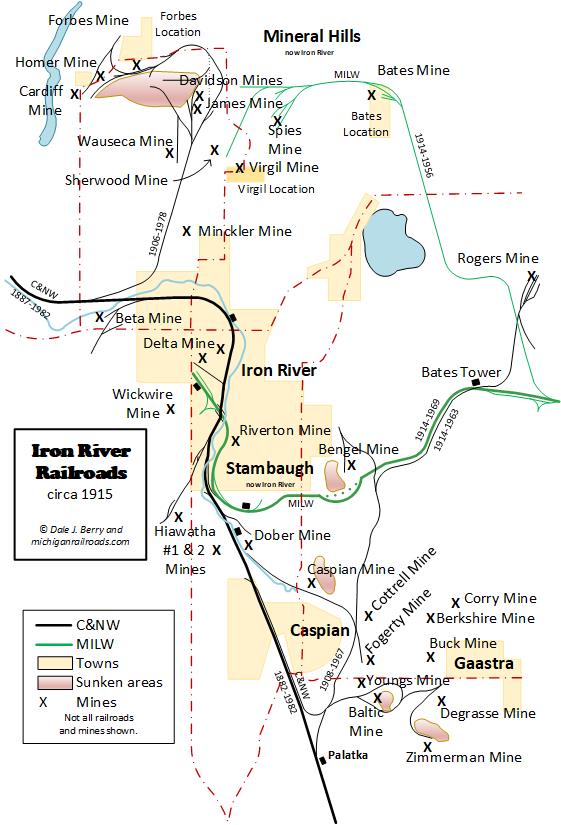- Details
- Hits: 5946
Station: Iron River, MI
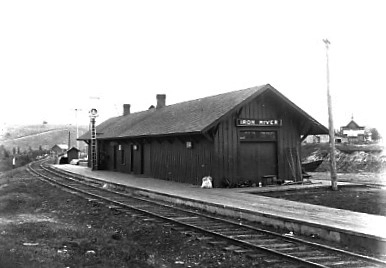
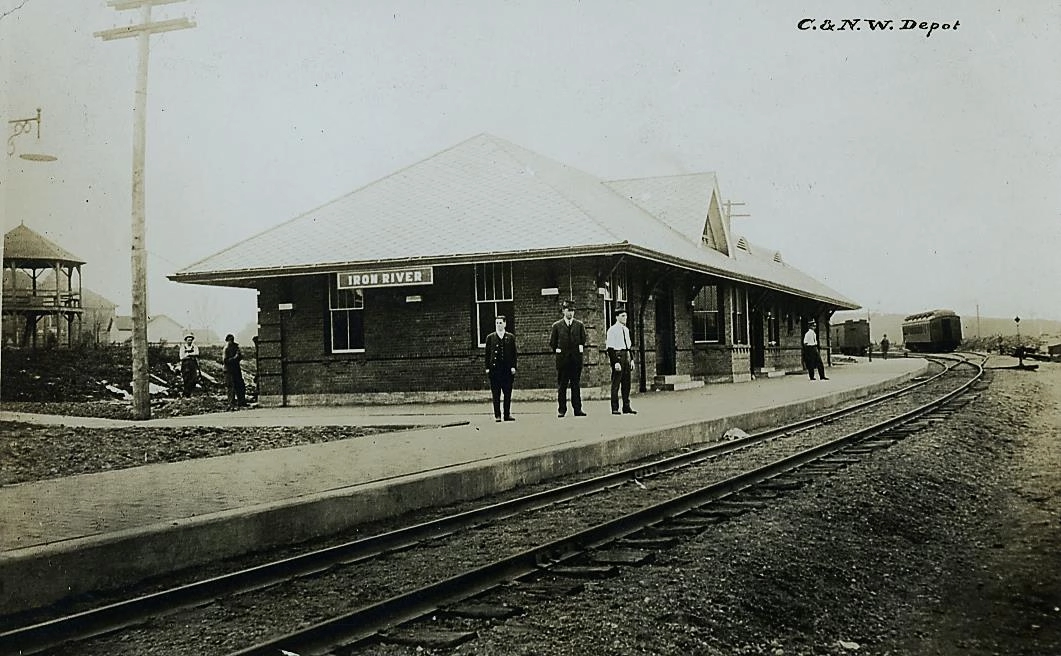
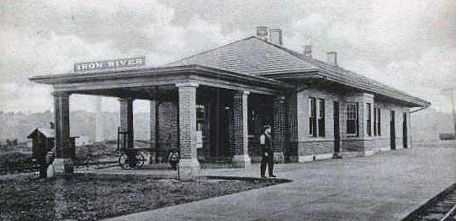
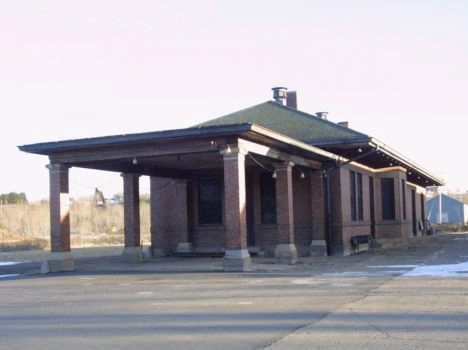
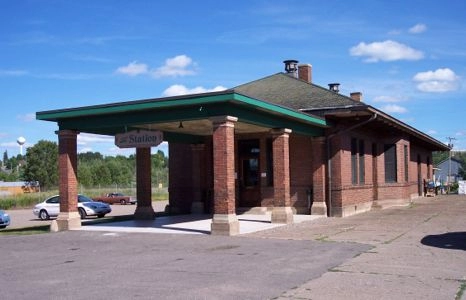 Exploration for iron ore in the Iron River area was begun in 1880. The first iron mine, the Iron River Mine, was opened soon after. The name of this mine was changed to the Riverton Mine sometime later.
Exploration for iron ore in the Iron River area was begun in 1880. The first iron mine, the Iron River Mine, was opened soon after. The name of this mine was changed to the Riverton Mine sometime later.
The mine's owner persuaded the Chicago and Northwestern to extend its line from Stager to Iron River, a distance of about 15 miles. The village was platted on the west bank of the Iron River and was the first settlement platted on the west side of Iron County.
The C&NW line to Iron River was completed in the fall of 1882. Although the original village grew rapidly, the Panic of 1893 stifled further growth for some time.
Photo Info: Top photo, a photo of what may have been the original depot at Iron River. 2nd photo, the C&NW Iron River station on Selden Street was built about 1910. [UPM]. Other photos, the Milwaukee Road depot at Iron River.
Notes
From 1889 to 1900, no ore was mined on the entire west side of Iron County, including near Iron River. During this period, residents turned to logging for employment. Small logging railroads penetrated parts of western Iron County, allowing for harvesting of hardwood stands after the pine was removed.
The turn of the century saw the areas greatest period of growth, with a steady increase of pig iron using the soft, phosphoric ores found around Iron River. New mines were developed at a rapid pace after ore was discovered outside of the Iron River valley at the James Mine in Mineral Hills in 1905.
From 1905 to 1912, the number of mines increased from six to 16. The Village installed a sewer system in 1905 and electric light facilities in 1908. The 1910 census showed a population of 7,816 on the west side of Iron County.
Iron River encompassed the Beta and Nanaimo mines.
The cluster of towns around Iron River (Caspian, Stambaugh, Gaastra and Mineral Hills) were united by public transportation in 1913 when a street railway franchise was granted to the Iron River and Crystal Falls Street Railway Company. The 4 and 1/2 mile long line operated until 1921, only eight years. It never reached Crystal Falls.
Iron River was incorporated as a village in 1885 (in Marquette county at the time) and as a city in 1926. The Great Depression forced the closing of most mines and although some reopened at the beginning of World War II, the mining industry never again regained its earlier high level of production. [DFP-1885-0325]
The MILW reached their depot at Iron River via a tall viaduct going over the river valley and the C&NW.
The MILW had two bridges north of Stambaugh, crossing over the CNW main line at milepost 26.1 and 26.2. [MRL]
The MILW branch from Crystal Falls to Iron River was abandoned and removed in 1969. The C&NW line was removed in 1982. [MRL], ending railroad service.
In 2000, Iron River, Stambaugh and Mineral Hills merged to form the new City of Iron River.
[Information researched from an article from the Iron County Historical Society, written by Marcia Bernhart]
On the MILW, the Iron River telegraph office was designated as "RO". [ETT-1944]
Iron River Map
Time Line
1884. Deputy Sheriff M.J. Griffin of Iron River, Marquette County, was shot while in the performance of his duties at that place at 3 o'clock this morning. A disturbance arising at a Swedish dancing house, Griffin attempted to arrest the participants and in the course of the melee was fired upon by August Anderson, a Swede. The ball, of thirty-two caliber, entered Griffin's left side, in the region of the heart, inflicting what is feared is a fatal would. Anderson took to the woods and is still at large. The people of Iron River are terribly incensed and had Anderson been captured during the day it is probably that the threats that have been freely uttered would have culminated in lynching. A large number of citizens are searching the woods. [DFP-1884-0625] Griffin did not die but remained in ill health. The ball cannot be extracted. He was awarded $500 by the Marquette County Board of Supervisors. [CCA- 1885-1231]
1887. Iron River boasts of ten C&NW engines and train crews. [DD-1887-0618]
1887. A ladies' waiting room has been opened in the C&NW Iron River depot. [DD-1887-1015]
1889. August 12. The Iron River mine is sold to Frederick Schlesinger of Milwaukee, representing a syndicate of New York capitalists already interested in the region. [DFP-1889-0813]
1891. The police Marshall of Iron River was shot while investigating a man under the influence of liquor who reacted to people throwing snow balls at him. He went home, got a gun, and then shot Chief Ed Scott and several others. The man was finally arrested by Under Sheriff Flannigan, who also kept enraged citizens from lynching his prisoner. He was taken to the local jail and then transferred to Menominee by train for safe keeping. It is thought that both wounded men will die. [DFP-1891-0225]
1891. April. An individual under the influence of liquor seriously shot City Marshall William Leroy and another individual. The Cornish miners were drunk and boisterous and Marshall Leroy ordered them to keep quite, and a battle ensued with a shotgun and Winchester rifle. When the smoke cleared, Leroy was found shot through the body and may die. The other individual lost his left arm which was shattered by buckshot. The shooter is in jail. [DFP-1891-0418]
1892. The lock up at Iron River burned down for the second time within a year. This time an old woman, who had been on a "tear" was the only occupant. There was no attendant and when the fire was discovered the flames were seen coming from the cell occupied by the old woman lying helplessly drunk and who perished in the flames. [GRH-1892-0418]
1893. August. Monday night burglars blew off the outer door of the safe in the C&NW depot at Iron River with dynamite. The front side of the depot is also demolished. The burglars failed to effect an entrance to the safe. [DFP-1893-0809]
1893. November. For the 3rd time in its history, Iron River has suffered from a disasterous fire. Fire broke out in the lumber yards of the Iron River Lumber company. The fire department responded and did some splendid work, saving various buildings near the yards as well as about a third of the lumber and mills. Four million feet of lumber were burned. [TAC-1893-1111]
1901. Mine owners (Oliver) and village officials consider changing the course of the Iron River (through the city), which flows over the Riverton mine at Stambaugh. The Miller Mine is also affected, which adjoins to the north. The Miller is not worked at the present time with ore being taken out of the Iron River mine. Of the routes surveyed for the river, one crosses to the west of Iron River village connecting with the river again through a gully away to the south of the mine. A large cut will be necessary to turn the water through this channel. A route east of Stambaugh hill through Ice Lake has also be talked of. This would be expensive as the one to the west of the village but would take the water further away from the mine. The Oliver company also had the thought of running a rock tunnel through the great hill on the foot side of the vein. [DD-1901-0427]
1913. November. On the CM&StP only about a half mile of track has yet to be laid before the line will be completed to Iron River. The trestle over the Northwestern tracks and the highway which skirts the hill there will have to be erected to complete the new railroad. [DD-1913-1115]
1913. The top shipping iron mines from the Iron River area in 1913 were: the Caspian (295,841 tons); the Davidson (195,448 tons); the James (188,966 tons); the Riverton (160,818 tons), the Hiawatha (160,510 tons); the Zimmerman (150,817 tons); the Chicagon (137,002 tons); the Baltic (130,631 tons); and the Fogarty (124,568 tons). The remaining eight iron mines each shipped less that 100,000 tons. [DD-1914-0321]
1918. MILW had a station agent here on the day shift. The C&NW also had an operator during the day at their station. [TRT]
1922. August 13. C&NW locomotive engineers at Iron River quit because of defective equipment, blamed on a shop man's strike. [NYT]
1937. A deluge of protests - telegrams, letters and telephone calls - advised officials of the St. Paul railroad over the weekend that the proposal to curtail sleeper and passenger service in and out of Iron River does not meet with the approval here. Mining men especially are voting their objection to the new schedule which goes into effect May 28 and which will discontinue sleeper service and replace the present passenger train with a mixed train between Channing and Iron River. Many merchants have also expressed their displeasure. [IDG-1937-0512]
1959. January 3. Railroad Asks Change of Track at Stambaugh. Washington (AP) - The Milwaukee Road has asked the Interstate Commerce Commission for authority to relocate it operations in the vicinity of Iron River and Stambaugh.
The company proposes to abandon about two miles of trackage in and around Stambaugh because it has been advised that an iron ore mining operation is approaching the right of way with threat of cave-ins.
The Milwaukee has contracted with the Chicago & Northwestern Railway for use of about five miles of its tracks as a substitute route between Stambaugh and Iron River. [IDG]
Time Line for Iron River (Includes Stambaugh, Mineral Hills, Caspian and Gaastra):
1880. Iron ore exploration here.
1882. Nearby village of Stambaugh is platted, as is the Village of Gaastra.
1882 Chicago & Northwestern railroad builds into Iron River from Iron Mountain.
1882 The Naniamo Mine is sunk in Iron River and works until 1908.
1882. The C&NW builds a spur to the Beta and Manaimo mines, which is extended in 1948 to the Buckholz mine. The line is removed in 1963. They also build the Iron River mine spur in 1882 to the Iron River mine. This spur is extended in 1920 to the Delta mine. The spur to Delta is removed in 1926, and the line to Iron River Mine is removed in 1982.
1884. The C&NW builds a spur from their main line to the Riverton and Dober No. 2 mines, which is extended to the Caspian mine in 1903. Part of the line is removed in 1937 and the entire spur is removed in 1967.
1885. Iron River is incorporated as a village. Becomes a city in 1926.
1885. The Beta Mine in Iron River begins. It closes in 1887 but ships from stockpile in 1891 and from 1941-1942.
1887. The C&NW continues west from Iron River to Watersmeet, meeting up with the C&NW line from Wisconsin to Ironwood via Watersmeet (built to Watersmeet in 1883 and to Ironwood in 1884).
1889. The spur from the C&NW main line to the Sheridan mine is installed in 1889 but removed by 1900. The mine is worked from 1889 to 1900 when it is exhausted.
1891. The city of Caspian was platted between Stambaugh and Gaastra. Caspian was originally names Palatka and became the headquarters of the Verona Mining Co., which operated the Caspian, Verona and Fogarty mines.
1893. The C&NW builds the Chatham mine spur in 1893 (about 1 mile) and then to the North Hiawatha and Wickwire mines in 1907. These lines are removed by 1966. Hiawatha Mine No. 1 is reached off this spur (1893-1950).
1893. The Panic of 1893 reduces iron ore purchases for several years in the region.
1893. Hiawatha Mine No. 1 is started, including parts of the Wickwire, Anna, West Hiawatha, Stegmiller and North Hiawatha mines. Mining continues here into the 1950's.
1900. The Baltic mine in Caspian begins operation.
1901. The C&NW builds a spur to the Baltic mine in 1901, and reaches Gaastra and the Zimmerman and DeGrass mines in 1907. The spur is removed in 1967.
1901. The Buck Mine Group (Baltic, Berkshire (Corey "40"), Buck, DeGrasse (1950), Zimmerman and Fogarty begins operation.
1903. The Caspian mine is opened and produces until 1937.
1904. The Youngs Mine in Gaastra begin an underground mine which produces until 1928.
1906. Village of Mineral Hills north of Iron River is founded.
1906. The C&NW builds a connecting spur from their main line north to the Davidson #3 mine and the Forbes mine in Mineral Hills. The line is extended to the Purcell mine in 1914. Other spurs on this line are built to the Davidson No. 1 mine (1911-1953), Osana/James Mine (1906-1953), Wauseca-Minckler mine (1915-1968), Sherwood mine (1931-1978), and the Homer mine (1914-1969). These spurs are removed in 1969.
1907. The C&NW builds a spur from the main line to the Caspian, Mansfield and Fogarty mines. The spur is removed in 1967.
1907. The Chatham mine opens and produces until 1920.
1907. The Fogerty Mine in Gaastra opens and produces until 1962. Became part of the Buck Mine in 1922.
1907. The Zimmerman underground mine begins operation in Gaastra and operates into the 1950's. It became part of the Buck Group around 1944.
1908. The C&NW begins the Bates Mine branch in 1908, reaching the Rogers Mine (4.3 miles) by 1914. This line is abandoned between 1963 and 1967. Spurs off this line include the Baker Mine spur (1908-1915), the Berkshire Mine spur (1908-1950), and the Bengel Mine spur (1913-1963).
1909. The underground Baker Mine is established, producing until 1915.
1909. The Tully Mine begins operation, followed by the Bengal Mine in 1913. The mines, later known as the Cannon Mine continue operations in the 1950's.
1910. The Bates Mine begins underground operation, reaching over 2,000 feet. It operates until 1947.
1910. The Wauseca and Aronson mines in Mineral Hills combine and operation into the 1950's. Depth 1,142 feet.
1911. The Davidson Group of mines in Mineral Hills begin operation with 4 shafts reaching about 900 feet. Operate into the 1950's.
1911. The Forbes Mine opens in Mineral Hills and produces until 1946.
1912. C&NW builds the Cortland Mine spur in 1912, removed in 1914.
1912. The Rogers Mine takes over the (Blair, Erickson, Swanson, Paulsen and White mines) in Iron River. Operates until 1945.
1914. The Milwaukee Road (MILW) - Chicago, Milwaukee, St. Paul and Pacific) reaches the Iron River area from Crystal Falls and the Chicagon area, bringing a 2nd railroad to town and offering mining companies competition in ore transportation rates. The MILW also builds the Bates Mine spur reaching the Bates Mine, as well as in the Mineral Hills area, including the Virgil Mine, the Tully Mine and other mining spurs. The line is removed in 1956.
1914. The Homer Mine takes over operations of the Cardiff, McGovern, Keweenaw and Minckler mines. It continues to produce into the 1950's.
1915. The Cottrell Mine opens and produces until 1916. In 1950, the Verona Mining Co. uses this mine to operate the Berkshire which adjoins it.
1915. The Spies-Virgil Mine opens in 1915 (formally two separate mines). Produces into the 1950's.
1917. The MILW builds spurs off its Bates mine spur, reaching the Spies Mine.
1917. Officers from the sheriff and state police sent confiscated beer, wine and liquor on the MILW passenger train from here to Crystal Falls as evidence and to be deposited in the county storage room. After use as court evidence, it will be poured into the Paint River where it will help make electric current. [DD-1917-0819]
1919. The Cardiff Mine opens in Mineral Hills, operates until 1923.
1920. The Delta Mine in Iron River opens and produces until 1925.
1931. The Sherwood Mine operates in Mineral Hills, closing in 1978. this is the last working mine in Iron River.
1935. The Hiawatha Mine No. 2 at Caspian begins operation (including the former Duff, Dober and Isabella mines). It continues to produce into the 1950's.
1936. The Brule Mine begins operation in Stambaugh and operates until 1936. This was sometimes called Hiawatha No. 3 mine.
1937. The C&NW and Milwaukee Road create a ore pooling arrangement. From this point forward all ore is transported to the port in Escanaba. A slow process of removing duplicate mine spurs is begun.
1944. The MILW telegraph office at Iron River was opened from 8:00 am to 5:00 pm. [ETT]
1950. The Cannon Mine sinks a new shaft, as part of the Bengal-Tully-Cannon Mine. The De Grasse Mine begins operation in Gaastra.
1956. The MILW removes the Bates mine spur.
1969. The Milwaukee Road abandons operations in the Iron River area and removes their rail. The C&NW continues to serve the area for thirteen more years until 1982.
1978. The Sherwood Mine closes in Mineral Hills. This is the last working mine in the Iron River area.
1982. The C&NW main line between Iron Mountain and Watersmeet is abandoned and removed, including all trackage in the Iron River area.
2000. The city of Stambaugh and the village of Mineral Hills are consolidated with the City of Iron River.
See Also (click below):
Aronson Mine
Bates Mine
Beta Mine
Blair Mine
Buckholtz Mine
Campbell-Sherwood Mine
Cardiff Mine
Chicagon Mine
Davidson Group Mines
Delta Mine
Dober Mine
Duff Mine
Greig-Kelly-Jackson Mine
Hiawatha Mine No. 1
Homer Mine
Bibliography
The following sources are utilized in this website. [SOURCE-YEAR-MMDD-PG]:
- [AAB| = All Aboard!, by Willis Dunbar, Eerdmans Publishing, Grand Rapids ©1969.
- [AAN] = Alpena Argus newspaper.
- [AARQJ] = American Association of Railroads Quiz Jr. pamphlet. © 1956
- [AATHA] = Ann Arbor Railroad Technical and Historical Association newsletter "The Double A"
- [AB] = Information provided at Michigan History Conference from Andrew Bailey, Port Huron, MI

